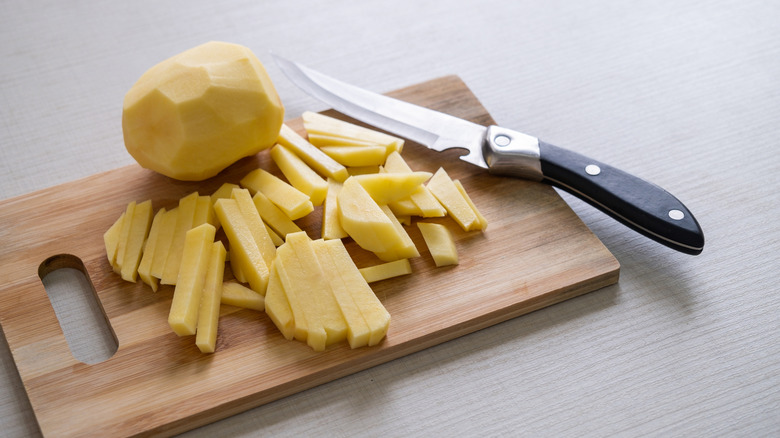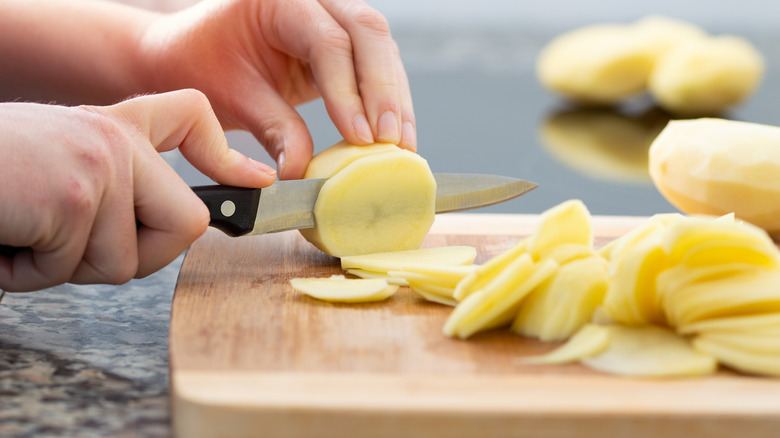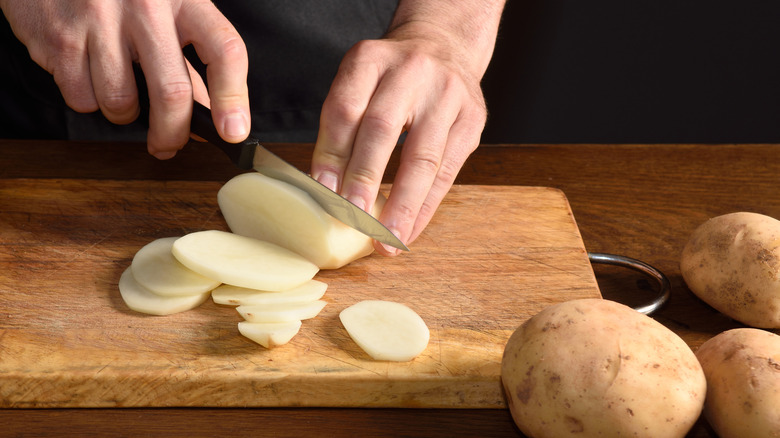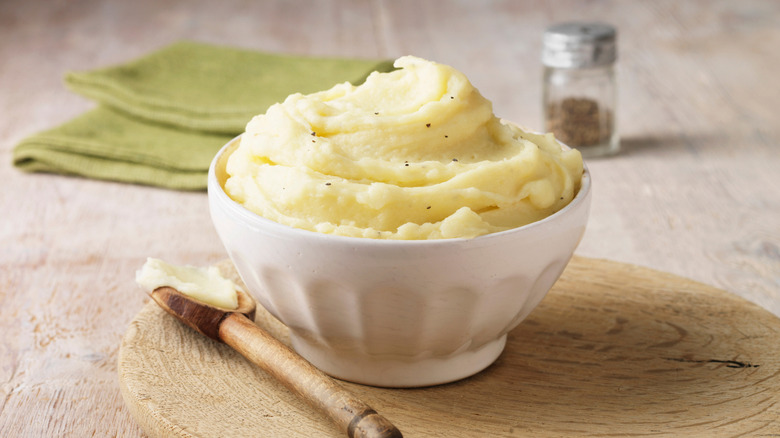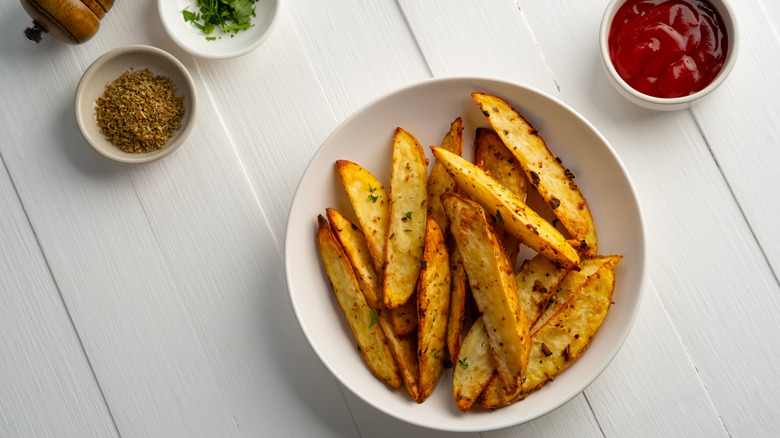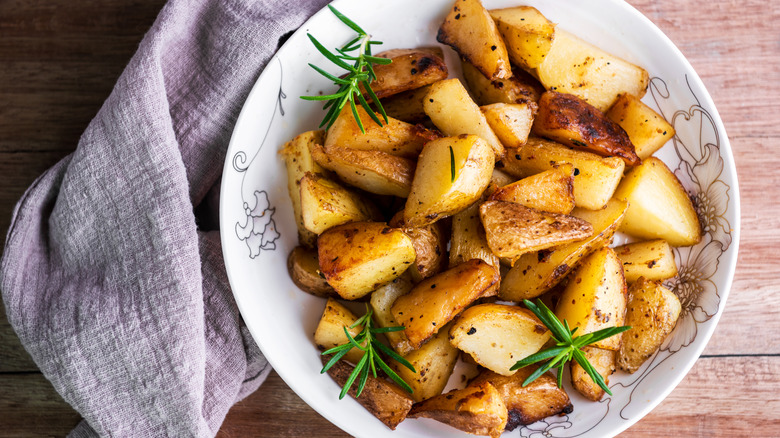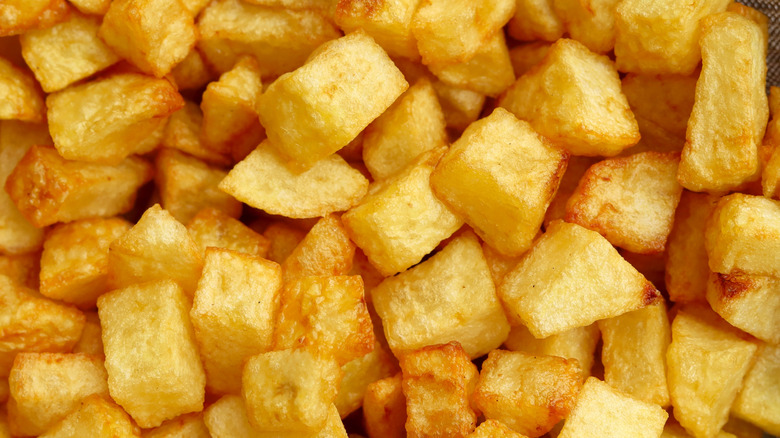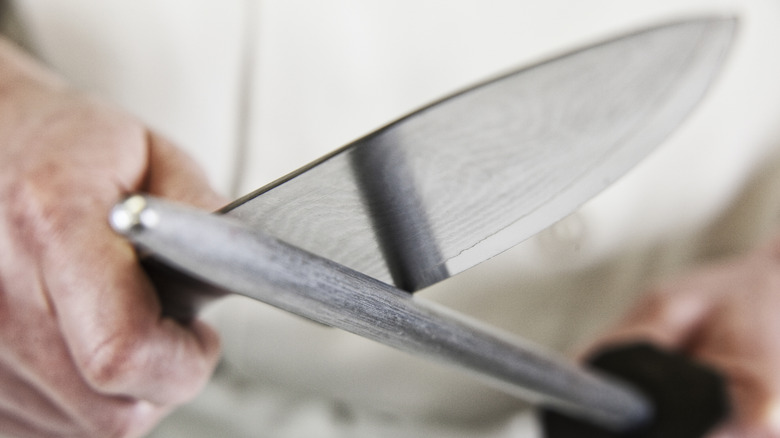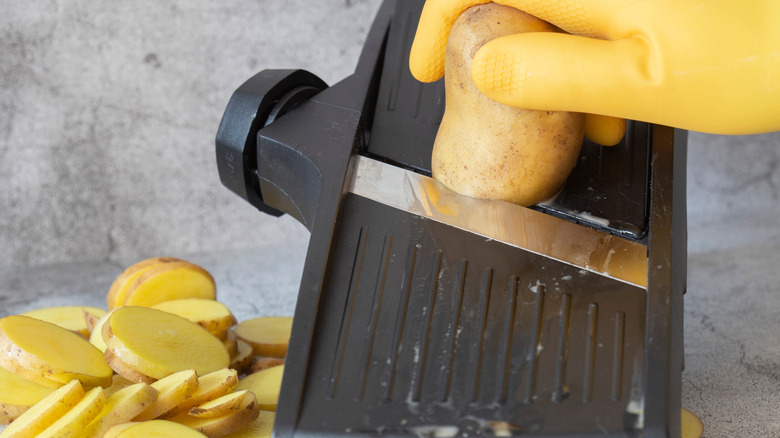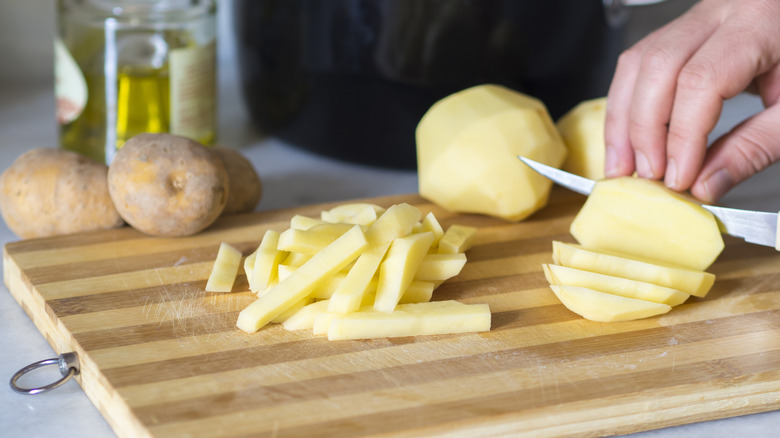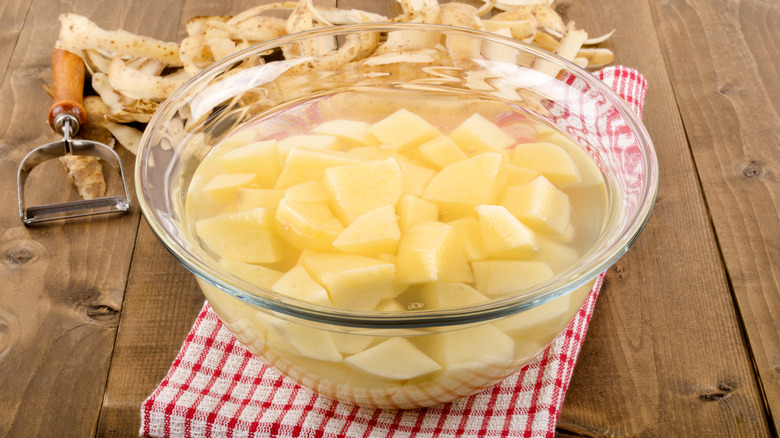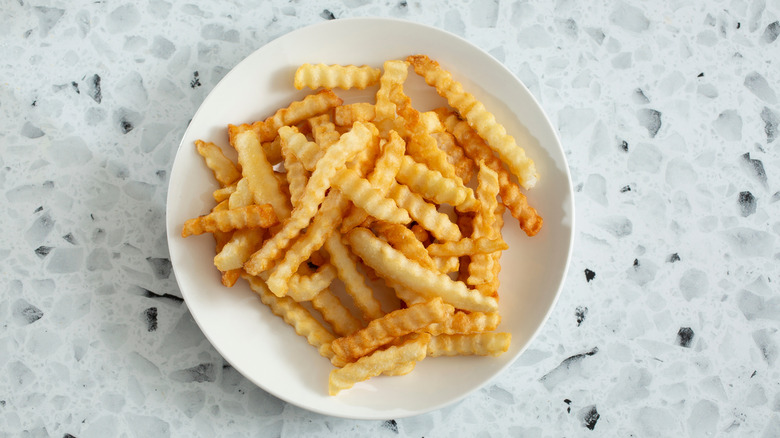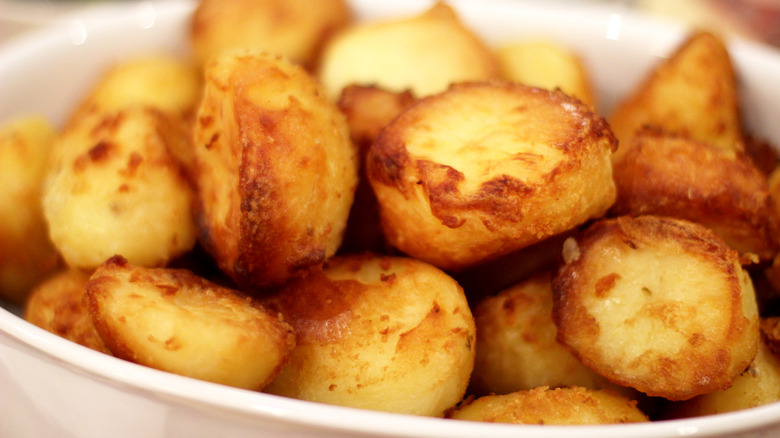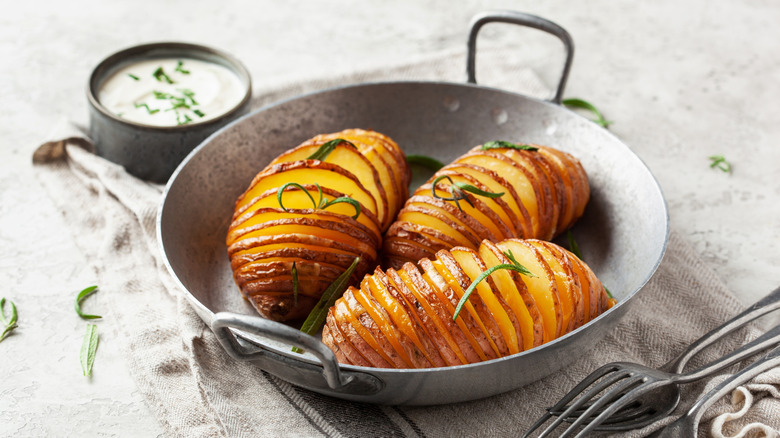Everyone Makes These Same Mistakes When Slicing Potatoes
We may receive a commission on purchases made from links.
When you last sliced a potato, how did it go? Be honest. We're willing to bet that it probably wasn't a disaster, but we're also willing to bet that it might not have been as smooth as it could have been. Slicing potatoes may seem simple, but the truth is that pretty much everybody does it in ways that are messier and more cumbersome than they should be. This is largely down to potatoes' lumpy, bumpy shape and texture, which can make it difficult to cut them with grace and accuracy — leading to a lot of wasted potato flesh, and a few knicks and cuts along the way.
It's important to remember that cutting potatoes isn't a one-size-fits-all approach. There are a lot of different ways to slice your spuds, and whether you're going for a fry cut, making Hasselback potatoes, or fixing some loaded potato skins, you'll need to alter your approach. You'll also need to think about your equipment more than you probably are: Your choice of knife and the surface you use will impact your final result enormously. Ready to rise above the rest in the potato slicing game? Let's go.
Mistake: Using an up-and-down motion with your knife to cut potatoes
Slicing is simple, right? You just go up and down with your knife, and you're done. Well, when slicing potatoes you need to think about a different direction. The right way to slice potatoes is actually not to use an up-and-down motion, but rather a horizontal one. This method, which is favored by chef J. Kenji López-Alt, involves the knife having very little contact with the potato at all: All you do is drag your knife through the potato in one deft motion, slicing it while your blade glides through it without the potato gluing itself to the metal.
When you use this technique, you prevent the potato from getting stuck to your knife for the simple reason that there's less surface tension due to the constant motion of the blade going through. Bear in mind that when you're doing this, you may end up scoring the cutting board underneath it more than you normally would. It's therefore best to use an old or plastic cutting board, or one that you don't mind getting knife marks in. Plus, you'll want to hold onto your potato while you cut it, so that you don't end up dragging it off the cutting board.
Mistake: Forgetting to create a base for your potato
When cutting potatoes into any shape, you're presented with an immediate problem: The vegetable's roundness. Trying to slice them means having to contend with their round base while you do so, which can lead to them slipping and sliding all over your board, potentially flying off into the corner of your kitchen. The best way to avoid this is by creating a base with your potato. Before you start slicing them, trim off a small portion of one of the longer sides to give them a stable base. Then you can maneuver your potato at will.
This is a useful trick when you're working with any type of potato cut (unless your potato needs to remain round, like with Hasselback potatoes), but it's especially useful when it comes to making french fries. To cut french fries by hand, you'll need each of your potato planks to be equally sized and a consistent width throughout. Trying to do this with a potato that still has a rounded underside can be hard, as your knife doesn't have the same entry angle every time.
Mistake: Slicing your potatoes too small before simmering them
Making mashed potatoes is one of life's great pleasures, but that pleasure can quickly turn to pain if you're slicing your potatoes incorrectly. One of the key mistakes that people make when cooking mash is to slice their potatoes into chunks that are too small. On the surface, this feels like a logical thing to do: The smaller your chunks are, the more quickly they'll cook, and the sooner you'll have steaming mashed potatoes on your plate.
However, the problem is that when you cut your spuds too small and then boil them, they're far more likely to overcook and take on too much water. This results either in mashed potatoes that have way less potato than you'd like, and instead turning into a starchy liquid, or they'll become too soggy from absorbing all of that liquid. This wateriness will also prevent any dairy you add into your mash from properly soaking into the potatoes. Instead, you'll want to go a bit bigger than you think with your potato chunks. Aim for them to be about 2 inches across or slightly smaller. Plus, ensure that all of your potatoes are cut to the same size, so that they cook at an equal rate.
Mistake: Slicing your potatoes into different widths
Unevenly cooked wedges are always disappointing. Sadly, this is an all too common occurrence with potato wedges, which are surprisingly easy to mess up due to being uneven sizes. This usually happens when people take a random approach to slicing their wedges and cut them straight out of a whole potato — which can lead to a seriously random assortment of shapes that will end up being the death of your dinner.
Instead, you should cut potato wedges evenly, aiming for the same width every time. The way to do this is easy. Begin by cutting your potato in half lengthways, aiming for an even size on each side. Place each side flat side down, and then halve them again. Continue to halve each piece until you end up with the right size wedges. If you have any scrappy pieces left over, it can be tempting to just throw them in with your other potato pieces — but trust us, you'll be better off throwing them out or reserving them for another dish.
Mistake: Cutting your potatoes lengthwise for loaded potato skins
Everyone loves a loaded potato skin, and we particularly love them when they're big, chunky, and stuffed to the gills with delicious ingredients. To achieve this stuffed nature for potato skins, people almost always slice their potatoes lengthwise. On the surface, this makes a lot of sense: The longer the piece of potato, the more delicious the skin, right?
Wrong. To make ultimate potato skins, you should change the way you're cutting them and slice them across the potato, or widthwise, instead. Doing this gives you way more depth and allows you to cram even more stuffing into your potato skins, creating an overall more generous experience for you and your guests. As well as this, slicing your potatoes widthwise means that each potato skin is a more manageable size and doesn't confront you with a massive, daunting chunk of potato and filling. They're way easier to pick up and chomp down in one go while you're talking to someone at a party, instead of having to stand awkwardly with half of the skin still balanced between your fingers.
Mistake: Forgetting to score your roasted potatoes after slicing them
If you're not scoring your potatoes before you roast them, you're making a big mistake. Scoring your potatoes before putting them in the oven creates way more surface area, which in turn leads to a crispier, more satisfying roasted potato. When you score a potato, you create loads of little rivets and corners for the heat to get into, giving more opportunities for browning across the flesh itself. You also don't need to cook them any differently, either, or change the roasting time at all.
When you're scoring your potatoes, it's important to be careful. You want to slide your knife just over the surface of the potato to create ridges, and not push down too much. Doing so risks you cutting pieces straight off the potato itself, which then leaves you with uneven chunks for roasting. You should also make sure you're using a sharp knife, so that you don't inadvertently rip the potato. If you've parboiled your potatoes, you can still score them — but just bear in mind that they'll be softer, and your knife will be more susceptible to plunging straight through the flesh.
Mistake: Dicing your potatoes without cutting them into planks first
Dicing potatoes is a skill that every chef should master. Unfortunately, many home cooks simply don't. Instead, they take a haphazard approach to dicing their potatoes, cutting their spud into random pieces and then trying to create small chunks from there, which results in uneven pieces and a poorly cooked result.
The way to avoid all of this is to slice your potatoes systematically, by turning them into planks first. Start by cutting one of the edges off the side of your peeled potato to give it a base, and then slice your potato into planks. Make sure to slice them evenly here. Once you've got your planks, lay them on top of each other and then cut them into large, chunky french fries. Rotate the whole potato structure 90 degrees, and then cut across the fries to dice your potatoes into small chunks. Repeat as many times as you need to until you have all the chunks you need. If you want to get really fancy and uniform, you can throw away the slightly misshapen chunks at the end of each french fry — but honestly, y'all, nobody's gonna be checking.
Mistake: Using the wrong type of knife
Most people don't think too much about the type of knife they're using to slice potatoes — they just grab the nearest sharp object and start chopping. While this might work in a pinch, if you're going to be slicing potatoes on a regular basis you need to think about your style of knife. Cian O'Sullivan, head chef for Gourmet Pantry, an artisanal food company based in Ireland, states via Food & Wine that a dimpled knife is the best choice when slicing potatoes. Dimples prevent the entire side of the knife from coming into contact with the potato flesh, which in turn prevents them gluing to the metal as you cut them.
It's best not to go with just any dimpled knife, though. A chef's knife will give you the best result every time. These knives have the right length and robustness to slice through denser vegetables like potatoes without any resistance, and they're a smart investment for any budding home cook. Ensure that you keep your knife well-sharpened, too, so that you can chop potatoes at a moment's notice.
Mistake: Not using a mandoline
Whether you're making a potato pave, scalloped potatoes, or potatoes au gratin, you'll likely need a mandoline to get the best results. A lot of people fail to see the value in this underrated kitchen tool, and instead try to use their regular knives to produce the super-thin slices needed for these layered potato dishes. Not only does this take way more time, but it requires a level of accuracy that can all too often fail us, leaving misshapen, irregular slices of potato on your chopping board — which will then go on to ruin your dish.
Conversely, using a mandoline ensures that you get perfectly equal slices every time. Most have adjustable blades that let you change the thickness of each cut so you can alter it to your needs. A lot of mandolines also have separate attachments or settings that allow you to make fries, julienne strips, or shred your potatoes. They can be a little frightening to use at first, but as long as you protect your hands while you're slicing, they should be no more risky than trying to get wafer-thin slices with your knife.
Mistake: Slicing potatoes on a slippery surface
Potatoes are one of the most irritating vegetables to slice, precisely because of their slipperiness. Starchy potatoes are especially hard to slice, thanks to the slightly slimy, milky-looking residue they can have on them after being peeled. If you're trying to work with one of these slippery 'taters on a plastic or wooden surface, you may find that your vegetable skids away while you're slicing it and ends up halfway across your kitchen.
It's a good idea to try to create a nonstick surface when cutting your potatoes. One of the easiest ways to do this is to put a cloth or some paper towel on top of your cutting board, which will create friction that will prevent your potato from slipping away. If you're using a thin paper towel, make sure that you don't rip it as you're slicing it, which can leave little scraps of it on your potato. You can also use a ridged or dimpled cutting board, which can prevent the potato from slipping. Plus, using the sharpest knife possible will limit the amount of elbow grease you need to use, which again will help keep them in place.
Mistake: Slicing your diced potatoes ahead of time
Chopping our vegetables beforehand is often a good way to get ahead. If you're dicing your potatoes ahead of time, though, you might end up making your dish worse before you've really started cooking. Cutting potatoes in advance can cause them to go brown on their exterior edges, thanks to the flesh beginning to oxidize once it comes into contact with the air. Oxidation won't make your potatoes inedible, but it'll ruin the way they look — and it may also cause their flavor to change slightly, losing that clean, smooth potato taste.
We're often told, though, that we can prevent oxidation by putting our potatoes in cold water, thereby preventing them from being exposed to air. So why can't we do that in this case? Well, when you soak potatoes in water, they can begin to lose their starch — and while this usually isn't a big issue for larger chunks of potato that are only soaked for a few hours, for smaller diced pieces that are chilling in water overnight it's a big issue. They can end up losing most or all of their starch, leaving you with a pile of potatoes that have no fluffiness and don't retain their shape.
Mistake: Trying to use a knife to slice crinkle-cut fries
How hard can crinkle-cut fries be? That's what most people think when they try them for the first time, usually by taking a knife and trying to cut zig-zag shapes into each side of the potato. These people generally do this for about five minutes before they realize that not only is it incredibly difficult, but they've ruined half of their fries by inadvertently slicing through them or creating irregular cuts that then make them cook at an uneven pace. In short: Making crinkle-cut fries with a knife is a minefield, people.
Rather than lump yourself with this futile task, invest in the right equipment. Crinkle-cut fries are made with a crinkle cutter, a utensil that resembles a comb without any gaps between its ridges. You can also pick up crinkle knives like the VITUER Crinkle Cut Knife, which will only set you back a few bucks. These knives are used just like your regular knife when slicing potatoes into fries. You just slice them into planks and then into fries, with the crinkle design leaving those delightful ridges in your potato. Just make sure you're cutting them evenly, as otherwise your crinkle-cut fries can end up pretty misshapen.
Mistake: Slicing potatoes to roast them, instead of tearing them
Roasting cooked or parboiled potatoes is nothing new. When you roast an already boiled or steamed spud, you don't have to worry about the inside being cooked. Instead, you can just focus on getting their exteriors to be as crispy as possible. The standard procedure when preparing your cooked potatoes for roasting, though, is to slice them once they're ready to go. When you do this, you limit the amount that they can crisp up, as slicing them leaves them with clean edges and corners that may look good, but don't lend themselves well to maximum crunch.
Instead, the easy way to get crispy potatoes is to tear them. Instead of slicing them cleanly, just wait for them to cool slightly and then rip them apart using your hands. This has more of an effect than just making you feel like the Incredible Hulk, tearing apart these puny weaklings with your bare fists. When you tear your potatoes, you separate them in a way that gives them ruffled, craggy edges. When they're roasted, this rough texture turns delightfully crispy, with plenty of corners for the heat to get into and brown.
Mistake: Forgetting to use chopsticks to slice your Hasselback potatoes
Hasselback potatoes are undeniably impressive. By slicing your potatoes part-way through, you simultaneously give them a unique appearance while exposing more of their surface area to heat, allowing them to brown effectively. If you've ever made Hasselback potatoes, though, you'll know how challenging they can be. Unless you're a total pro with your knife, you can end up slicing clean through the potato itself, or else leave your spud with lopsided slices that don't cook at the same rate.
The solution? A pair of chopsticks. Line a chopstick on each side of your potato, and slice until your blade hits them. Doing this will prevent you from cutting all the way through, and will give you uniform Hasselback potatoes every time. Crucially, you'll want to make sure your chopsticks are thick enough for you not to cut almost down to the base of the potato, as this can weaken them too much and cause them to break apart anyway. You'll also need to use chopsticks that are an equal thickness all the way through, instead of tapered ones that can leave your potatoes sliced at a gradient.
